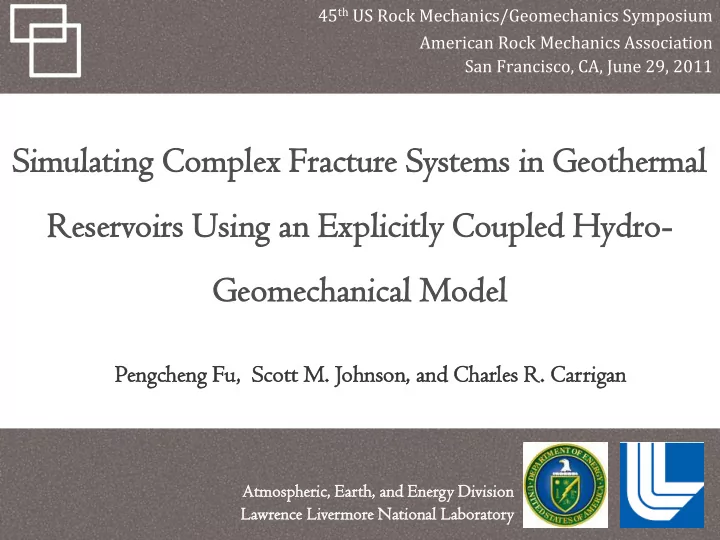

45 th US Rock Mechanics/Geomechanics Symposium American Rock Mechanics Association San Francisco, CA, June 29, 2011 Simulating mulating Complex mplex Frac acture ture Syste stems ms in Geoth othermal ermal Reservoirs servoirs Using ing an Expli licitly citly Coupled upled Hy Hydro ro- Ge Geomechanical omechanical Model del Pengc gcheng heng Fu, Scott ott M. Johnson, hnson, and d Char arles les R. Carrig rigan an Atmosphe spheri ric, c, Earth th, , and Energy Division Lawren ence ce Livermo more e Nati tional nal Laborato atory
Background • Hydraulic fracturing is an effective method for enhancing permeability of geological formations.
How real fracture system looks like (Large Block Test, Yucca Mountain. (Warpinski and Teufel, 1987) Wagoner, 2000)
State of the art PKN model PL3D model (Adachi et al. 2000)
What do we need to simulate hydrofrac? • Physical processes need to be covered: – Fluid flow due to pressure gradient; – Rock deformation; – Variation of aperture width; and – Rock fracturing.
Modules and their coupling
Important Components • Flow solver – Finite volume method h P q w Two mechanisms: q 0 l l t ― Flow in fractures due to pressure gradient. h 3 w ij ― Mass conservation with varying total ij 6 ( L L ) fracture volume. i j h 3 h 3 w w ( L L ) i j i j h 3 w ij h 3 h 3 w L w L i j j i V ( P P ) ij ij i j m i K 1 if m / V i i ref P V i i ref P if m / V vap i i ref
Important Components • Fracturing criterion – Estimates stress intensity factors using a generalized displacement correlation method – Handles mixed mode fractures • Adaptive remeshing
Model verification: classical KGD model Mesh of the numerical model Expected fracture path Extended simulation domain (partial) Injection well Core simulation domain 100 Predicted fracture growth rate Fracture length l (m) 80 60 1 40 2 3 6 Gq 0 3 l ( t ) 0 . 679 t Simulation Results 20 ( 1 ) KGD, closed-form solution 0 0 10 20 30 40 Injection time t (second)
Model validation: lab test results Blanton, 1982
Interaction Between Propagating and Existing Fractures σ yy =-10MPa Pumping σ xx =-20MPa 18MPa σ yy =-10MPa
Interaction Between Propagating and Existing Fractures
Interaction Between Propagating and Existing Fractures
Interaction Between Propagating and Existing Fractures
Interaction Between Propagating and Existing Fractures
Interaction Between Propagating and Existing Fractures
Interaction Between Propagating and Existing Fractures
Application to more complex fracture networks Zero-pressure flow boundary Injection well Core simulation domain Extended simulation domain (partially shown)
Application to more complex fracture networks Stress rotation Stress rotation Far field stress 10 MPa Less anisotropy 15 MPa Less anisotropy Less anisotropy 10 MPa 10 MPa 10 MPa 11 MPa 12 MPa 10 MPa
Application to more complex fracture networks
Concluding Remarks • Challenges: – The coupling of multiple modules. – High computational cost. • Benefits: – Explicit simulation of fracture-fracture and fracture-fluid interaction. – Capable of handling complex fracture networks. – Simple and physically meaningful input parameters. – Induced seismicity naturally emerges in the simulation. • Further development, enhancement, and validation
Acknowledgements • This work was performed under the auspices of the U.S. Department of Energy by Lawrence Livermore National Laboratory under Contract DE-AC52-07NA27344. Release number: LLNL-PRES-489801
Application to more complex fracture networks
800 Pres. along frac. P(kPa) l=25 m l=50 m 700 Model verification: classical KGD model l=75 m l=100 m 600 500 400 300 200 100 0 6 0 50 100 5 Apert. size w (mm) 4 3 2 1 0 12 10 8 1 Flow rate , q 2 3 6 6 Gq 0 3 l ( t ) 0 . 679 t 4 ( 1 ) 2 0 0 50 100 Distance from injection well (m)
Application to more complex fracture networks Post-stimulation Pre-stimulation fracture network fracture network
Application to more complex fracture networks σ xx σ yy Results published in ARMA 2011 Symposium
Application to more complex fracture networks Connected to Well A Connected to Well B
Application to more complex fracture networks (a) Case D-1, left pumping only (b) Case D-2, right pumping only 0.011 Darcy 0.013 Darcy (d) Case D-4, right-then-left pumping (c) Case D-3, left-then-right pumping 0.025 Darcy 0.026 Darcy
Application to more complex fracture networks 10 MPa 13 MPa In situ stress Production well Injection well Preexisting fracture Flow in unstimulated network fracture network Stimulated with 14 Stimulated with 16 MPa pumping pressure MPa pumping pressure
Application to more complex fracture networks P 1.50E+07 1.43E+07 1.36E+07 1.29E+07 1.21E+07 1.14E+07 1.07E+07 1.00E+07 Before stimulation After stimulation
Application to more complex fracture networks 5 years 5 years T T 300 300 266 266 231 231 197 197 163 163 129 129 94 94 60 60 Before stimulation After stimulation
Recommend
More recommend